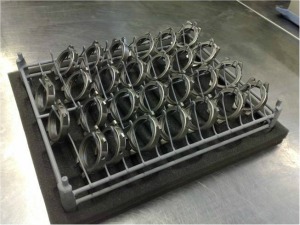Posts Tagged ‘industrial ultrasonic cleaner’
How to Position Parts in an Ultrasonic Cleaner

Correct parts positioning in an ultrasonic cleaner is as important as the ultrasonic cleaning frequency and ultrasonic cleaning solution formulation. Yet of these three criteria improper parts positioning is often the cause of unsatisfactory results or extended time in the cleaning solution.
Don’t Fight Cavitation
Better said, don’t impede cavitation action. Cleaning is accomplished by the violent implosion of minute bubbles created in the cleaning solution by ultrasonic transducers. The cleaning action occurs on all surfaces wetted by the solution as sound waves migrate upward through the solution from the bottom of the ultrasonic cleaner tank and reflect back down from the solution surface. This suggests that putting too much product in the cleaning baskets is not a good idea because it will impede sound reflection. At Tovatech we recommend a 1 to 2 inch space between the tank walls and parts in … Read the rest
Boost Efficiency with an Ultrasonic Cleaner
Here’s a note from a Tovatech customer:
In my shop selecting the correct ultrasonic frequency to employ when operating the ultrasonic cleaner depends on the items being cleaned and what is being removed. Coarse cleaning to remove heavy contaminants is generally best performed at lower frequencies such as 37 kHz because it delivers stronger cavitation action. Fine cleaning requirements use higher frequencies such as 80 kHz to create smaller, relatively gentle cavitation bubbles that more easily penetrate blind holes, threads, tight crevices and tubes.
It’s not unusual for us to get jobs that call for both coarse and fine cleaning on the same part. Sure, there are dual-frequency cleaners out there but for the most part they require manually switching frequencies from one to the other. And there are other variables we need to take into account depending on the objects being cleaned, all of which require close attention on … Read the rest